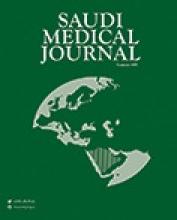Abstract
OBJECTIVE: To evaluate the efficacy of bronchial arteriography and bronchial artery embolization (BAE) in the management of massive hemoptysis in a developing Asian country.
METHODS: A retrospective review was carried out from March 2000 to March 2005 to evaluate the demographics, clinical presentation, radiographic studies, bronchoscopy results, and complications of bronchial arteriography and BAE at a tertiary care hospital in Pakistan.
RESULTS: Fourteen patients (9 males, 5 females) with a mean age of 49 years underwent bronchial arteriography and BAE for massive hemoptysis. Hemoptysis was caused by bronchiectasis (10 patients), active pulmonary tuberculosis (3 patients), and lung malignancy (one patient). A CT scan of the chest was carried out in 11 patients, which revealed bronchiectasis (8 patients), cavity with infiltrates (3 patients), and mass lesion (one patient). Bronchoscopy was performed in all patients. Bleeding lobe or segment was identified in 12 patients. Bronchial arteriography revealed hypervascularity (13 patients), bronchial artery hypertrophy (5 patients), hypervascularity with shunting (one patient), dense soft tissue staining (7 patients), extravasation of contrast (one patient) and pseudoaneurysm (one patient). Bronchial artery embolization was carried out in all patients. Rebleeding occurred within 24 hours in 2 patients who underwent surgery, and within one week in another 2 patients who were managed with repeat BAE. The complication of embolization occurred in one patient (transverse myelitis). Thirteen patients improved and were discharged home. One patient with terminal lung carcinoma died due to cardiogenic shock secondary to acute myocardial infarction.
CONCLUSION: Bronchial artery embolization is an effective method for management of massive hemoptysis in developing countries and has a low complication rate.
- Copyright: © Saudi Medical Journal
This is an open-access article distributed under the terms of the Creative Commons Attribution-Noncommercial-Share Alike 3.0 Unported, which permits unrestricted use, distribution, and reproduction in any medium, provided the original work is properly cited.






